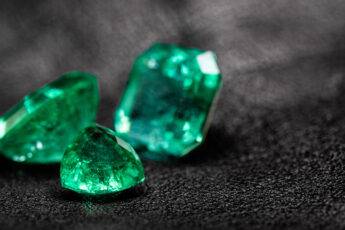Six Ways to Spot Fake Diamonds

The Earth Star Diamonds team want you to enjoy your jewelry without fear or wonder. Owning a diamond is a precious experience if owned without doubts.
The most obvious way to ensure that a diamond is real is to keep the certificate from the GIA or AGS that guarantees that the stone is genuine. However, as time passes and paperwork is mislaid, you may need other means of seeking corroboration that your diamond jewelry is real. Indeed, if you are looking to buy diamond jewelry, then you have the right to doubt and therefore to check the validity of the stone.
Test 1: Water Test
A crude test that can give you an idea if your stone is fake or not is to see if it floats in a glass of water. Diamonds are so dense that they cannot float. Most fake diamonds will float, as they are made of glass or quartz. They may sink eventually, but if they were diamonds, they would go straight to the bottom of the glass. Be aware that some fake stone material such as moissanite will sink relatively quickly and therefore this is not the most reliable test, though it will give you some idea.
Test 2: Temperature Test
A real diamond is unlikely to hold heat. You can use this to your advantage. If you take the diamond into a cold place and breathe warm moist air onto the diamond, it should not fog up. Fake diamonds are likely to fog just like your mirror or glasses when there is steam in a cold room. Although not a fool-proof method, it can give you a hint as to whether your concerns are warranted or not.
Test 3: Flame Test
You can do a similar temperature test if you are happy to lose the stone if it is fake. Place your diamond in tweezers and hold it in a flame for about half a minute. Then, drop it right away into iced water. A diamond will not react, but something made of glass, quartz or cubic zirconia will shatter during the test. If your diamond is a diamond, you should clean the stone thoroughly after the test to remove ash.
Test 4: Using a Magnifying Glass
You don’t need a jeweler’s eyeglass to check out a diamond carefully. You can use a microscope or a strong magnifying glass. You are looking for internal and external flaws knows as inclusions. Real diamonds are made by nature, and their beauty comes from the imperfections. If you look at the stone and it is entirely perfect, with few if any internal flaws, then it is probably cubic zirconia or moissanite. As these fake stones are created in labs, they are not subject to the same environmental pressures as diamonds.
It is easier to use this test if you have a genuine diamond that you are entirely confident is real. Look at the real diamond and then compare it to your questionable stone. You are looking for the quirks that you can see in the real diamond in the other one too.
Beware the temptation to throw your flawless stone in the trash. Some of the most expensive diamonds in the world are flawless, with the highest possible diamond clarity. It is highly unlikely that you somehow forgot you had some of the most valuable diamonds in the world, though it is best to check.
Test 5: The Reading Test
This is not the most reliable test in the world, though it will give you a sense of the validity of your stone. If you can read your newspaper through your stone, then it is unlikely to be a diamond. A real diamond will refract light, making it almost impossible to see the print through it. It might be that your diamond is too small for this to be a useful test, but if you are lucky enough to have a stone larger than half a carat, then it is a simple place to begin.
Test 6: Conductivity Test
The most common fake material in today’s diamond market is moissanite. As this stone conducts electricity, while a real diamond will not, you will find that most jewelers will own a conductivity tool. This is good news, as the skill of the craftsmen of moissanite is such that it has become increasingly challenging to tell the difference with the real thing. However, diamonds do not have the same level of thermal conductivity, so the simplest way to check for a fake is to use electricity.
YOU MIGHT ALSO LIKE:
Share via:






Leave a Comment